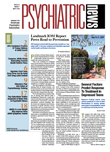A well-known psychiatrist joined advocates and congressional leaders in urging the adoption of more measures to cut suicides among American-Indian youth, who have some of the highest rates in the nation, according to the Centers for Disease Control and Prevention (CDC).
R. Dale Walker, M.D., director of the One Sky Center and a psychiatrist of Cherokee origin, told the Senate Indian Affairs Committee at a hearing in February on recent trends in youth suicide and prevention that increased efforts are needed to address a crisis among this population of youth.
Walker testified in his capacity as director of the One Sky Center and not on behalf of APA.
“We already know the technology of suicide prevention pretty well,” Walker said. “We just need a lot more of it, and we need to educate and train more personnel to deliver those interventions.”
The pressing need for increased efforts was highlighted by federal statistics cited by Eric Broderick, D.D.S., M.P.H., acting administrator of the Substance Abuse and Mental Health Services Administration, that indicate that suicide has become the second-leading cause of death—behind accidents and unintentional injury—for American-Indian and Alaska-Native youth and young adults aged 10 to 34.
From 1999 through 2004 the suicide rate for American Indians and Alaska Natives was 10.84 per 100,000, which was higher than the overall U.S. rate of 10.75, according to the CDC. Young American-Indian adults aged 25 to 29 had the highest rate of suicide among any racial group of the same age, 20.67 per 100,000.
And the problem may be growing worse, according to Broderick, who reported that in the two most recent years for which data are available, 2004 and 2005, the suicide rate among American Indians increased. The CDC's National Vital Statistics Report in 2005 found that the suicide rate for American-Indian youth and young adults aged 15 to 24 was twice as high as a national sample of age-matched individuals.
“What in and of itself is a tragedy to report is that more than one-half of all persons who die by suicide in the United States, and an even higher number in tribal communities, have never received treatment from mental health providers,” Broderick told the Senate committee.
Walker, a member of the Advisory Council of the National Institute on Drug Abuse and a past speaker of the APA Assembly, has previously testified before Congress on health and suicide prevention in American-Indian populations. He described at the recent hearing the efforts of the One Sky Center and other similar organizations to raise the public's awareness of mental health issues among American Indians, build coalitions, develop inventories of best practices, and provide suicide-prevention training.
Culture-Based Interventions Lacking
But a key problem he and others working in the area of American-Indian mental health have found is a lack of top-quality “culture-based interventions.” He urged the Senate committee to support innovative research on culture-based interventions through research mandates and financial support.
Such an approach also was urged by Teresa LaFromboise, Ph.D., an associate professor of counseling psychology and chair of Native-American Studies at Stanford University. She said the decisions related to suicidal behavior among the majority of American-Indian youth may be attributed to direct learning or modeling influences, such as the influence of family members' suicide attempts or deaths by suicide. Many risk factors for suicide are similar to risk factors for other problematic behaviors, she noted, such as alcohol and drug abuse or engaging in unsafe sex.
“When cast from this more social cognitive perspective, suicide and other forms of risk behavior are more likely to be preventable,” LaFromboise said.
Treat It as Chronic Illness
Other approaches, including treating suicidal thoughts and behaviors as a chronic illness, also offer promise, Walker said.
“The illness often begins in childhood and develops over years as a vulnerability, propensity, ability, and, finally, a determination to suicide,” Walker said. “Providing opportunities to develop life skills, commitment to community service, and involvement with nurturing and shaping family relationships create resiliency and capacity to meet the crises and challenges that otherwise precipitate suicide.”
Another area ripe for increased federal support is increased training for physicians and other professional staff in the skills of suicide risk assessment and intervention. In particular, Walker called for support of telehealth training services that can provide on-the-job continuing education through the resources of colleges and universities.
The urgent need for stepped-up suicide-prevention efforts was echoed by others.
Senate Majority Leader Harry Reid (D-Nev.) testified about his father's death by suicide at age 60.
He described as “significant steps forward” the passage in the last Congress of mental health insurance parity legislation and a measure to lower Medicare's coinsurance requirement for outpatient mental health care to the level charged for all other types of medical treatment.
Reid said he plans to reintroduce and push for passage of the Indian Health Care Improvement Act, which would authorize the Indian Health Service to establish a behavioral health prevention and treatment plan and create an Indian youth “telemental health program” focused on suicide prevention and intervention. The measure passed the Senate last year but was not acted on by the House.
